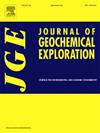伊朗赞詹上红组中新世砂岩中沉积型铜矿床的成矿作用
IF 3.4
2区 地球科学
Q1 GEOCHEMISTRY & GEOPHYSICS
引用次数: 0
摘要
位于伊朗西北部Zanjan地区的Chehrabad、Qezeljeh和Sarikand铜矿床被归类为沉积型铜矿(SHC)矿床。这些矿床主要由细粒浸染的贱金属硫化物胶结灰色砂岩组成,这些砂岩来自中新世红层厚层序(上红组:URF)。含矿灰色砂岩含碳质物质(植物化石)和细粒浸染状树状黄铁矿。铜、铅、锌和铁的硫化物代替了原生有机物以及草莓状黄铁矿。辉铜矿、方铅矿、闪锌矿、银云母、银云母、黄铁矿和少量黄铜矿、斑铜矿等矿石矿物在寄主砂岩的有机质和胶结物中替代存在。赞赞地区SHC矿床地球化学分析表明,灰色砂岩中Cu、Pb、Zn平均含量分别为5 wt%、6 wt%和3 wt%, Ag含量为~0.7 ~ 128 ppm, Cd含量为~ 0.1 ~ 821 ppm。本研究旨在提高对赞詹地区SHC矿床成因的认识,从而为该地区今后的勘探工作提供方向。采用电子探针显微分析(EPMA)方法测定了硫化物和碳酸盐矿物中铜、铅、锌、银的矿物化学特征和赋存状态。结果表明,银云母与含铜矿物(主要为辉铜矿和银云母)伴生。此外,还发现了单晶石矿物,以及少量的镉。赞赞SHC矿床的δ34S值在−1.90‰~ +12.9‰之间,表明硫可能来源于树状黄铁矿、有机质、蒸发岩层和URF的盐底液。硫化矿呈垂直分带,下部为Cu硫化物,上部为富铅锌矿。矿期硫化物矿物很可能是在中新世期间,在这些岩石沉积之后,源自下伏红色层的成矿流体渗入灰色砂岩层而形成的。成矿作用的氧化低温含金属卤水来源于盆地成岩过程中排出的高孔隙、高渗透性沉积物。成矿发生在有利的还原环境中,主要由有机质、草莓状黄铁矿和灰色砂岩层氧化低温卤水的还原提供。这些矿床的时代是典型的晚成岩时期。在寄主岩石岩性、矿物组合、矿石结构和构造以及整体成因解释等方面,与美国犹他州里斯本河谷和新墨西哥州Nacimiento等地的沉积岩层状铜矿相似。本文章由计算机程序翻译,如有差异,请以英文原文为准。
Metallogenesis of the sediment-hosted copper deposits in the Miocene sandstones from Upper Red Formation, Zanjan, NW Iran
The Chehrabad, Qezeljeh, and Sarikand copper deposits, located in the Zanjan district in northwestern Iran, are classified as sediment-hosted copper (SHC) deposit. These deposits mainly consist of fine-grained, disseminated base-metal sulfides cementing grey sandstones from the thick sequences of Miocene red beds (Upper Red Formation: URF). The ore-hosting grey sandstones contain carbonaceous materials (fossil plants) and fine-grained, disseminated framboidal pyrite. Copper, lead, zinc, and iron sulfides replace primary organic material as well as framboidal pyrite. Ore minerals such as chalcocite, galena, sphalerite, argentite, covellite, pyrite and minor chalcopyrite and bornite occur as replacement in organic matter and cement of the host sandstone. Geochemical analyses of the SHC deposits in the Zanjan district show an average of 5 wt% Cu, 6 wt% Pb and 3 wt% Zn, ~0.7 to 128 ppm for Ag, and ~ 0.1 to 821 ppm for Cd in the grey sandstone. This research aims to enhance the comprehension of the genesis of the SHC deposits in the Zanjan district, thereby providing direction for future exploration efforts in the area.
Electron probe micro-analysis (EPMA) was used to determine the mineral chemistry and occurrence of copper, lead, zinc, and silver in sulfide and carbonate minerals. The results reveal that argentite is associated with Cu-bearing minerals (mainly chalcocite and covellite). Furthermore, the presence of montetrisaite mineral, along with minor amounts of cadmium, has been identified. The studied samples from Zanjan SHC deposits show a range of δ34S values from −1.90 ‰ to +12.9 ‰ values, indicating sulfur might have originated from framboidal pyrite, organic matter, evaporite layers, and salt diapirs of URF. The sulfide ore is vertically zoned, with Cu sulfides at lower stratigraphic levels and Pb-Zn-rich ore at the upper part. Ore-stage sulfide minerals were likely formed by the infiltration of ore-forming fluids originating from the underlying red beds into the grey sandstone layers during the Miocene, following the deposition of these rocks. The oxidized, low-temperature, metalliferous brine responsible for mineralization originated from highly porous and permeable sediments expelled during diagenetic events in the basin. Mineralization occurred within a favorable reducing environment, mainly provided by organic matter, framboidal pyrite, and reduction of the oxidized, low-temperature brine in the grey sandstone horizons. The timing of these deposits is typically late diagenetic. Concerning host rock lithology, mineral assemblages, fabric and structure of the ores, and the overall genetic interpretation, they are similar to the sediment-hosted stratiform copper deposits elsewhere such as Lisbon Valley (Utah, USA) and Nacimiento (New Mexico).
求助全文
通过发布文献求助,成功后即可免费获取论文全文。
去求助
来源期刊

Journal of Geochemical Exploration
地学-地球化学与地球物理
CiteScore
7.40
自引率
7.70%
发文量
148
审稿时长
8.1 months
期刊介绍:
Journal of Geochemical Exploration is mostly dedicated to publication of original studies in exploration and environmental geochemistry and related topics.
Contributions considered of prevalent interest for the journal include researches based on the application of innovative methods to:
define the genesis and the evolution of mineral deposits including transfer of elements in large-scale mineralized areas.
analyze complex systems at the boundaries between bio-geochemistry, metal transport and mineral accumulation.
evaluate effects of historical mining activities on the surface environment.
trace pollutant sources and define their fate and transport models in the near-surface and surface environments involving solid, fluid and aerial matrices.
assess and quantify natural and technogenic radioactivity in the environment.
determine geochemical anomalies and set baseline reference values using compositional data analysis, multivariate statistics and geo-spatial analysis.
assess the impacts of anthropogenic contamination on ecosystems and human health at local and regional scale to prioritize and classify risks through deterministic and stochastic approaches.
Papers dedicated to the presentation of newly developed methods in analytical geochemistry to be applied in the field or in laboratory are also within the topics of interest for the journal.
 求助内容:
求助内容: 应助结果提醒方式:
应助结果提醒方式:


